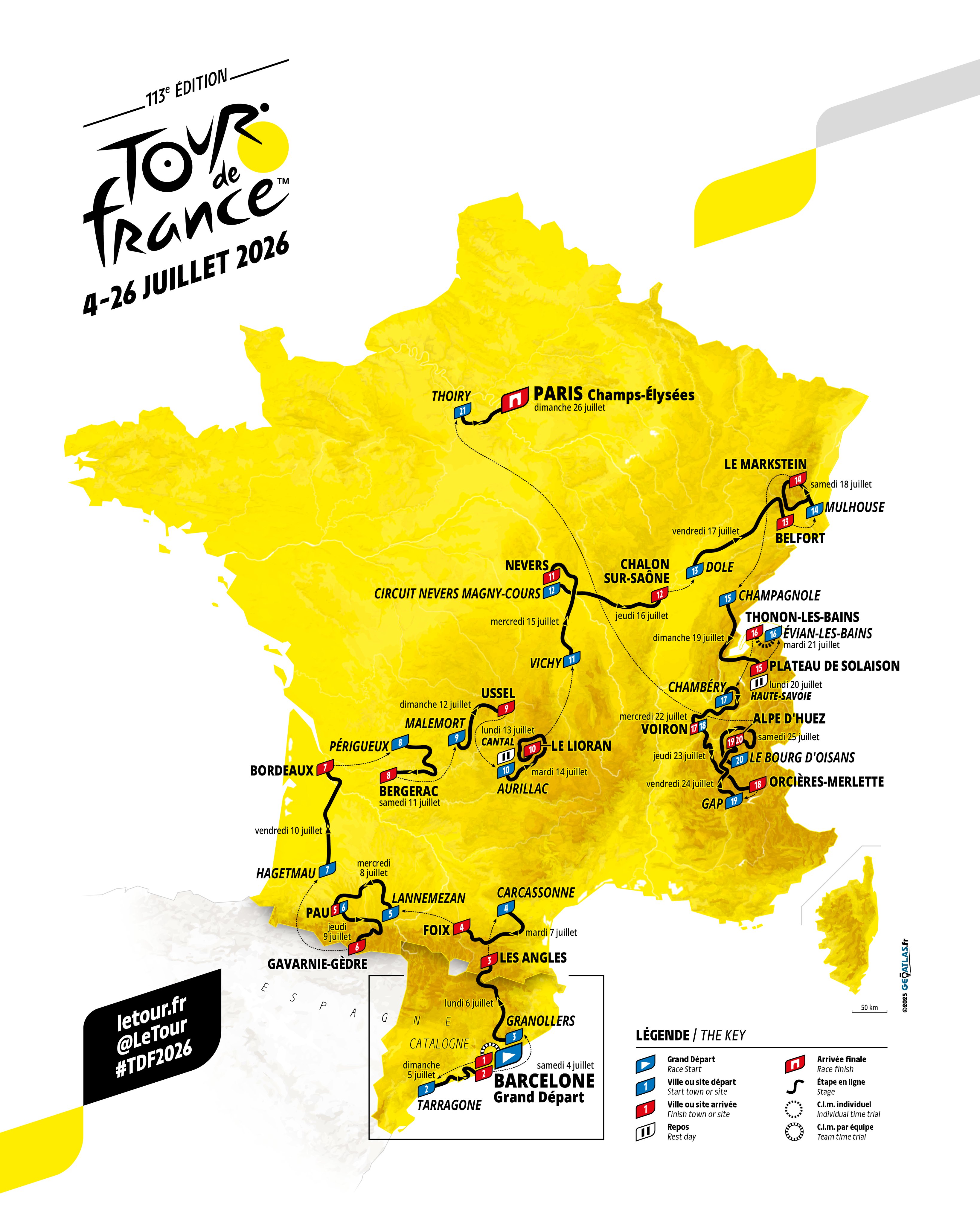Tour de France 2026 route: Pyrenees, Massif Central, Vosges and two separate stages up Alpe d'Huez, before Montmarte finish in Paris
Race to take place 4-26 July, with Grand Départ in Barcelona, before a clockwise route


The 2026 Tour de France will begin in Barcelona, Spain, before tackling the Pyrenees, the Massif Central, the Vosges, before two separate stages finish up Alpe d'Huez.
The route for the 113th edition of the race was unveiled in a presentation inside Paris's Palais des Congrès on Thursday. It will be the fourth foreign Grand Départ in five years, with three stages in Spain, before the race returns to France.
The Tour will finish in Paris once again, but this time with a stage around Montmartre, repeating 2025, with minor changes.
Next year's race will begin on Saturday 4 July in Barcelona, Spain and will then end in Paris on Sunday 26 July, a week before the Tour de France Femmes avec Zwift.
There is one team time trial, an individual time trial, as well as eight stages classified as mountain days, including five summit finishes. There is only one stage over 200km, seven are designated as "flat", and four as "hilly".
Tour de France 2026 stage table
Stage | Day | Start | FInish | Distance | Type |
|---|---|---|---|---|---|
1 | 4 July | Barcelona | Barcelona | 19.7km | TTT |
2 | 5 July | Tarragona | Barcelona | 178km | Hilly |
3 | 6 July | Granollers | Les Angles | 187.3km | Mountains |
4 | 7 July | Carcassonne | Foix | 182km | Hilly |
5 | 8 July | Lannemezan | Pau | 158km | Flat |
6 | 9 July | Pau | Gavarnie-Gèdre | 186km | Mountains |
7 | 10 July | Hagetmau | Bordeaux | 175km | Flat |
8 | 11 July | Périgeux | Bergerac | 182km | Flat |
9 | 12 July | Malemort | Ussel | 185km | Hilly |
10 | 14 July | Aurillac | Le Lioran | 167km | Mountains |
11 | 15 July | Vichy | Nevers | 161km | Flat |
12 | 16 July | Circuit Nevers Magny-Cours | Chalon-sur-Saône | 181km | Flat |
13 | 17 July | Dole | Belfordt | 205km | Hilly |
14 | 18 July | Mulhouse | Le Markstein Fellering | 155km | Mountains |
15 | 19 July | Champagnole | Plateau de Solaison | 184km | Mountains |
16 | 21 July | Évian-les-Bains | Thonon-les-Bains | 26km | ITT |
17 | 22 July | Chambery | Voiron | 175km | Flat |
18 | 23 July | Voiron | Orcières-Merlette | 185km | Mountains |
19 | 24 July | Gap | Alpe d'Huez | 128km | Mountains |
20 | 25 July | Le Bourg d'Oisans | Alpe d'Huez | 171km | Mountains |
21 | 26 July | Thoiry | Paris | 130km | Flat-ish |
Tour de France 2026 full route map

Tour de France 2026 week one overview
The race opens with a team time trial, the first in the Tour since 2019 in Brussels. This time, the riders will be racing around Barcelona, with a finish up Montjuic which will be sure to cause gaps. Like recent TTTs at Paris-Nice, time will be taken individually rather than as a collective. Don't get dropped.
The following day sees another finish in Barcelona, up Montjuic as happens at the Volta a Catalunya, after a start in Tarragona. This will be a punchy day again; Tadej Pogačar's first stage win?
The latest race content, interviews, features, reviews and expert buying guides, direct to your inbox!
France beckons on stage three, after a start in Granollers; it means the Pyrenees come very early. There are 3,950m of elevation on this stage, but the race's organisers think this one is one for the breakaway. The final climb is 1.7km at 7%.
Stage four is fully en France, with a break or puncheur win likely coming in Foix; the start in Carcassonne means the citadel will feature for the 14th time.
Next up is another familiar finish, Pau, in the Tour for the 77th time; this is the first stage that is almost nailed-on as a sprint. The last time there wasn't a bunch sprint until stage five was 2015. The day begins in Lannemezan.
It's back to the Pyrenees from Pau, as always, with the Col d'Aspin and Col du Tourmalet on the menu for stage six. The race doesn't finish there, though, but on the Cirque de Gavarnie, 18.7km at 4%, but there are multiple kilometres at 8%. If the GC battle hasn't already ignited, it will here.
Stage seven brings a sprint finish, as ever, in Bordeaux after the race leaves Hagetmau. The capital of Nouvelle-Aquitaine hosts the Tour for the 82nd time; Jasper Philipsen won here last time, in 2023.
Another sprint finish follows on stage eight from Périgeux to Bergerac, with the organisers making up to the fast men for the mountains featured so far.
The first week ends with a hilly day in Corrèze with 3,300m of climbing. This isn't a GC day, probably, but stage nine from Malemort to Ussel could be one for a rider like Ben Healy.
Tour de France 2026 week two overview
After a rest day in Cantal, and a mountain stage to begin the second week, with stage 10 from Aurillac to Le Lioran, with four climbs on the route. The race last finished here in 2024, when Jonas Vingegaard out-sprinted Tadej Pogačar. On Bastille Day 2026, will there be a French winner?
Next is another sprint stage on day 11, from Vichy to Nevers, although race director Christian Prudhomme hopes for a "brave move".
Stage 12 begins on Circuit Nevers Magny-Cours, the former home of the French Grand Prix, and this will be another sprint finish in all probability, with a finish in Chalon-sur-Saône.
Eastern France is given special focus over the next few days with stage 13 heading to Belfort from Dole. This is the only stage above 200km, at 205km, and features an ascent of the Ballon d'Alsace, before a finish in the prefecture of Belfort.
It's back to the mountains on stage 14, with the Grand Ballon before the Haag, "a forest trail that’s been converted into a bike path". This is 11.2 kilometres at an average of 7.3%, before the finish on Le Markstein, where the race's penultimate stage happened in 2023.
The second week ends with an epic mountain stage on day 15, withe the vertiginous climb to Le Salève via the Col de la Croisette including almost 5km at 11.2%, before the final Plateau de Solaison climb – 11.3km at 9.1%. The race could be decided on a day like this.
Tour de France 2026 week three overview
After a rest day in the Haute-Savoie, the final week begins with the only individual time trial of the race, from Évian-les-Bains on Lac Leman to Thonon-les-Bains. It's 26km-long but not completely flat. Remco Evenepoel, the TT world champion, will already have his eyes on this one.
A final thanks to the sprinters comes on stage 17, a largely flat day from Chambéry to Voiron; if the green jersey competition is still live, this finish will matter.
Stage 18 sees the race once again head upwards, on a day from Voiron to Orcières-Merlette. 15.3km at 4.6% might not be the most testing, but there will be a lot of teams and riders still looking for success.
Finally, the race gets to Alpe d'Huez on stage 19, 40 years after the famous Greg LeMond-Bernard Hinault showdown. On the first stage of two finishing on the Alpe, the Col Bayard, Col du Noyer and Col d'Ornon will be tackled before the famous 21-hairpin climb. Tom Pidcock won here last time, in 2023.
However, it is stage 20 which should be circled; it is the Tour's biggest mountain stage, with 5,600m of climbing, and is the first time this decisive day has come on the penultimate stage. The Col de la Croix de Fer, the Télégraphe and Galibier are on the menu before the back way to Alpe d'Huez up the Col de Sarenne. Simple.
Stage 21 is no picnic, either, with a repeat of the Montmartre stage in Paris, as opposed to the classic Champs-Élysées sprint. Rue Lepic will be back, but the final ascent will be 15km from the finish, giving more chance to storng sprinters.

Adam is Cycling Weekly’s news editor – his greatest love is road racing but as long as he is cycling, he's happy. Before joining CW in 2021 he spent two years writing for Procycling. He's usually out and about on the roads of Bristol and its surrounds.
Before cycling took over his professional life, he covered ecclesiastical matters at the world’s largest Anglican newspaper and politics at Business Insider. Don't ask how that is related to riding bikes.
You must confirm your public display name before commenting
Please logout and then login again, you will then be prompted to enter your display name.